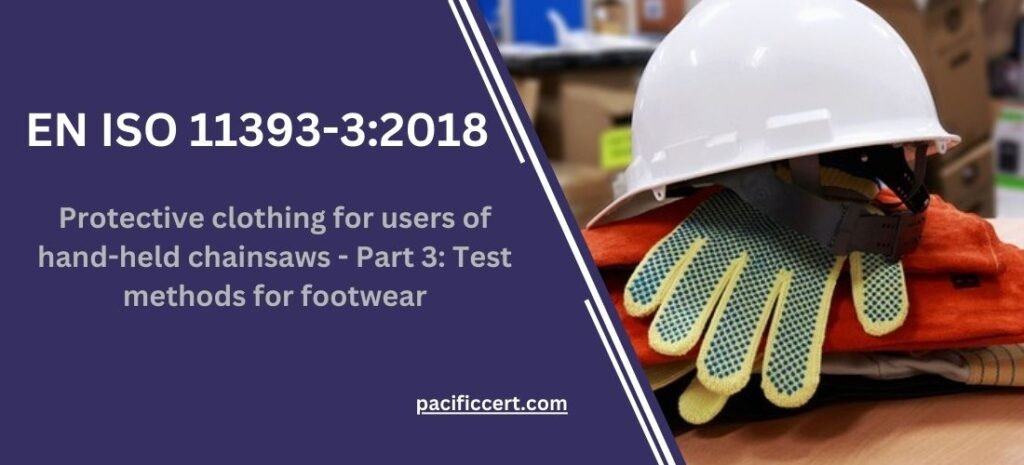
What is EN ISO 11393-3:2018- Protective clothing for users of hand-held chainsaws – Part 3: Test methods for footwear?
EN ISO 11393-3:2018 specifies the test methods for protective footwear designed for users of hand-held chainsaws. The standard is part of a series of standards related to protective clothing for users of hand-held chainsaws, which also includes EN ISO 11393-1 (protective trousers), EN ISO 11393-2 (protective gloves), and EN ISO 11393-4 (upper body protection).
The purpose of EN ISO 11393-3 is to establish test methods for determining the performance of protective footwear designed to provide protection to the feet of users of hand-held chainsaws during use. The standard sets out specific testing procedures that measure the footwear’s ability to resist cuts and impacts from a chainsaw. As well as its resistance to penetration by chainsaw teeth.
The tests specified in the standard include the impact test, cut resistance test, and chainsaw penetration test. The impact test assesses the footwear’s ability to withstand an impact from a falling object, while the cut resistance test evaluates the footwear’s ability to resist cuts from chainsaw blades. The chainsaw penetration test measures the ability of the footwear. To prevent chainsaw teeth from penetrating through the sole of the shoe.
EN ISO 11393-3:2018 aims to ensure that protective footwear designed for users of hand-held chainsaws provides adequate protection against the specific hazards associated with chainsaw use. So,By adhering to the requirements of this standard, manufacturers can ensure that their protective footwear products are tested. And meet the necessary performance standards to provide the required level of protection to the wearer.
Requirements of EN ISO 11393-3:2018
EN ISO 11393-3:2018 specifies the test methods for protective footwear designed for users of hand-held chainsaws. The standard outlines specific testing procedures that measure the footwear’s ability to resist cuts and impacts from a chainsaw. As well as its resistance to penetration by chainsaw teeth.
The requirements of this standard include the following:
Impact resistance test: The footwear should be subjected to an impact test to assess its ability to withstand an impact from a falling object. The test involves dropping a weight onto the footwear from a specified height. And measuring the force transmitted to the foot.
Cut resistance test: The footwear should be subjected to a cut resistance test to evaluate its ability to resist cuts from chainsaw blades. The test involves exposing the footwear to a chainsaw blade at a specified speed. And measuring the time it takes for the blade to penetrate the footwear.
Chainsaw penetration test: The footwear should be subjected to a chainsaw penetration test to measure its ability to prevent chainsaw teeth from penetrating through the sole of the shoe. The test involves exposing the footwear to a chainsaw at a specified speed. Also, measuring the depth of penetration of the chainsaw teeth.
Additional requirements: The standard also includes additional requirements for the construction and design of protective footwear. Such as the use of specific materials and the provision of ankle protection.
Benefits of EN ISO 11393-3:2018
Improved safety: The standard specifies test methods that ensure the protective footwear provides adequate protection against the hazards associated with chainsaw use. So, By complying with the standard, manufacturers can provide users with footwear that minimizes the risk of injury.
Consistency: This standard provides consistent testing procedures, making it easier for manufacturers to produce protective footwear that meets the required standards. This ensures that users can rely on the footwear to provide the necessary protection.
Compliance: Adhering to the requirements of the standard ensures that protective footwear products comply with relevant safety regulations and standards, thereby increasing the likelihood of regulatory approval and market acceptance.
Confidence: Users can have confidence in the protective footwear they are wearing. Knowing that it has been tested and certified to meet the required standards. Thus, This can help improve worker confidence and productivity and reduce the likelihood of accidents and injuries.
Therefore, EN ISO 11393-3:2018 provides a comprehensive set of test methods and requirements that ensure protective footwear products provide adequate protection against the specific hazards associated with chainsaw use.
Who needs EN ISO 11393-3:2018- Protective clothing for users of hand-held chainsaws – Part 3: Test methods for footwear?
EN ISO 11393-3:2018 is intended for use by manufacturers of protective footwear designed for users of hand-held chainsaws, as well as testing laboratories and certification bodies. The standard specifies test methods for evaluating the resistance of protective footwear to chainsaw cutting. Thereby ensuring that the footwear provides adequate protection against the hazards associated with chainsaw use. Users of hand-held chainsaws. Such as forestry workers, landscapers, and arborists, may also benefit from the use of protective footwear that conforms to this standard.
Pacific Certifications is accredited by ABIS, if you need more support with EN 11393-3, please contact us at +91-8595603096 or support@pacificcert.com
Read About: EN ISO 374-1:2017







